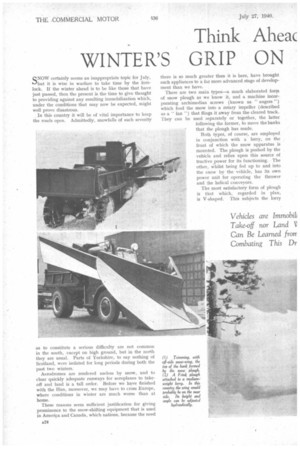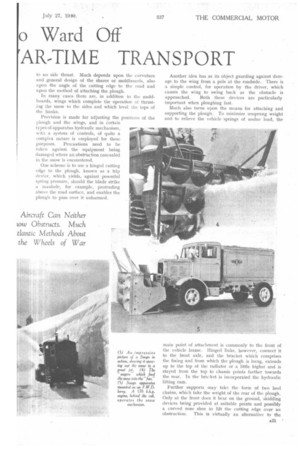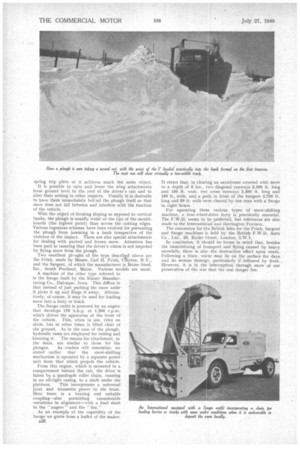Think Aheac o Ward Off WINTER'S GRIP ON AR-TIME TRANSPORT
Page 26

Page 27

Page 28

If you've noticed an error in this article please click here to report it so we can fix it.
SNOW certainly seems an inappropriate topic for July, but it is wise in warfare to take time by the forelock. If the winter ahead is to be like those that have just passed, then the present is the time to give thought to providing against any resulting immobilization which, under the conditions that may now be expected, might well prove disastrous.
In this country it will be of vital importance to keep the roads open. Admittedly, snowfalls of such severity as to constitute a serious difficulty are not common in the south, except on high ground, but in the north they are usual. Parts of Yorkshire, to say nothing of Scotland, were isolated for long periods during both the past two winters.
Aerodromes are rendered useless by snow, and to clear quickly adequate runways for aeroplanes to takeoff and land is a tall order. Before we have finished with the Hun, moreover, we may have to cross Europe, where conditions in winter are much worse than at home.
These reasons seem sufficient justification for giving prominence to the snow-shifting equipment that is used in AmeriFa and Canada, which nations, because the need there is so much greater than it is here, have brought such appliances to a far more advanced stage of development than we have.
There are two main types—a much elaborated form of snow plough as we know it, and a machine incorporating archimedian screws (known as "augers ") which feed the snow into a rotary impeller (described as a " fan ") that flings it away from the cleared track. They can be used separately or together, the latter following the former, to move the banks that the plough has made.
Both types, of course, are employed in conjunction with a lorry, on the front of which the snow apparatus is mounted. The plough is pushed by the vehicle and relies upon this source of tractive .power for its functioning. The other, whilst being fed up to and into the snow by the vehicle, has its own power unit for operating the thrower and the helical conveyors.
The most satisfactory form of plough is that which, regarded in plan, is V-shaped. This subjects the lorry to no side thrust. Much depends upon the curvature and general design of the shares or moldboards, also upon the angle of the cutting edge to the road and upon the method of attaching the plough.
In many cases there are, in addition to the moldboards, wings which complete the operation of thrusting the now to the sides and which level the tops of the banks.
Provision is made for adjusting the positions of the plough and the wings, and in certain types of apparatus hydraulic mechanism, with a system of controls, of quite a complex nature is employed for these purposes. Precautions need to be taken against the equipment 'being damaged where an obstruction concealed in the snow is encountered.
One scheme is to use a hinged cutting edge to the plough, known as a trip device, which yields, against powerful spring pressure, should the blade strike a manhole, for example, protruding above the road surface, and enables the plough to pass over it unharmed. Another idea has as its object guarding against damage to the wing from a pole at the roadside. There is a simple control, for operation by the driver, which causes the wing to swing back as the obstacle is approached. Both these devices are particularly important when ploughing fast.
Much also turns upon the means for attaching and supporting the plough. To minimize unsprung weight and to relieve the vehicle springs of undue load, the main point of attachment is commonly to the front of the vehicle frame. Hinged links, however, connect it to the front axle, and the bracket which comprises the fixing and from which the plough is hung, extends up to the top of the radiator or a little higher and is stayed from the top to chassis points farther towards the rear. In the bracket is incorporated the hydraulic lifting ram.
Further supports may take the form of two heel chains, which take the weight of the rear of the plough. Only at the front does it bear on the ground, skidding devices being provided at suitable points and possibly a curved nose shoe to lift the cutting edge over an obstruction. This is virtually an alternative to the
spring trip plate as it achieves much the same object. It is possible to raise and lower the wing attachments from ground level to the roof of the driver's cab and to alter their setting in other respects. Usually it is desirable to have them immediately behInd the plough itself so that snow does not fall between and interfere with the traction of the vehicle.
With the object of forming sloping as opposed to vertical banks, the plough is usually wider at the tips of the mould boards (the highest point) than across the cutting edges.
Various ingenious schemes have been evolved for preventing the plough from jamming in a bank irrespective of the violence of the impact. There are also special attachments for dealing with packed and frozen snow. Attention has been paid to insuring that the driver's vision is not impeded' by flying snow from the plough.
Two excellent ploughs of the type describld above are the Frink, made by Messrs. Carl H. Frink, Myton, N.Y., and the Sargent, of which the manufacturer is Maine Steel, Inc., South Portland, Maine. Various models are made.
A machine of the other type referred to is the Snogo built by the Klauer Manufacturing Co., Dubuque, Iowa. This differs in that instead of just pushing the snow aside it picks it up and flings it away. Alternatively, of course, it may be used for loading snow into a lorry or truck.
The Snogo outfit is powered by an engine that develops 170 b.h.p. at 1,200 r.p.m. ' which drives the apparatus at the front of the vehicle. This, when in use, rides on skids, but at other times is lifted clear of the ground. As in the case of the plough, hydraulic rains are employed for raising and lowering it. The means for attachment, in the main, are similar to those for the
ploughs. As readers will remember, we stated earlier that the sno-shifting mechanism is operated by a separate power unit from that which propels the vehicle.
From this engine, which is mounted in a compartment behind the cab, the drive is taken by a quadruple roller chain, running in an oil-tight casing, to a shaft under the platform. This incorporates a universal joint and transmits power to the front. Here' tnere is a bearing and suitable coupling—also permitting considerable variations in alignment—with a final shaft to the " augers " and the " fan."
As an example of the capability of the Snogo we quote from a leaflet of the maker. A26
It states that, in clearing an aerodrome covered with snow to a depth of 6 ins., two diagonal runways 3,300 ft. long and 150 ft. wide, twc cross runways 2,500 ft. long and 100 ft. wide, and a path in front of the hangars 2,700 ft. long and 50 ft; wide were cleared by one man with a Snogo in eight hours.
For operating these various types of snow-shifting machine, a four-wheel-drive lorry is practically essential. The F.W.D. seems to be preferred, but references are also made to the International and Herrington Forrison.
The concession for tLe British Isles for the Frink, Sargent and Snogo machines is held by the British F.W.D. Auto Co., Ltd., 24, Ryder Street, London, S.W.1.
In conclusion, it should be borne in mind that, besides the immobilizing of transport and flying caused by heavy snowfalls, there is also the destructive effect upon roads. Following a thaw, water may lie on the surface for days and do serious damage, particularly if followed by frost.. However, it is in the interruption through snow of our prosecution of the war that the real danger lies.




















































